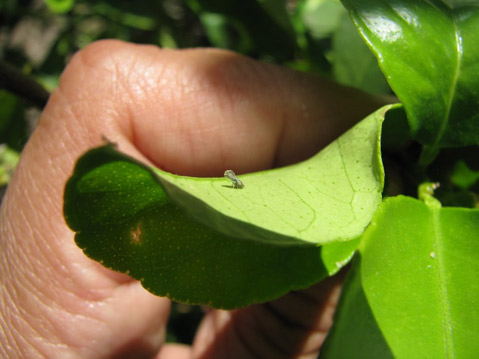Pesticide Spray Ongoing to Eradicate Asian Citrus Psyllids
Citrus Trees Treated to Contain Potential for Citrus Greening Disease

Pesticide spraying for Asian citrus psyllids — a tiny louse that can carry the dreaded huanglongbing (HLB) bacteria — by the state started in the Carpinteria area this past week and is moving toward Goleta’s citrus trees in the coming week, and throughout the county within the month, said Tina Galindo, head of SoCal’s extermination efforts. Properties in the treatment zones have been tagged with blue notices that include date of treatment information, a phone number to opt out of the free program, and information about the pesticides being used.
So far in California, HLB has only been found among psyllids in 28 trees in the San Gabriel area, which were destroyed, said Galindo, who is a California Department of Food and Agriculture (CDFA) environmental protection manager and works out of the San Fernando Valley. Though psyllids have been found on 532 properties in Santa Barbara County, according to CDFA, DNA studies on the leaves of the trees they infested did not confirm HLB. Galindo thought it was just a matter of time before members of the infected San Gabriel colony get loose. Psyllids have so far been less prevalent in coastal areas, she added, and are widespread in eastern Ventura County and in the Los Angeles area.
Commercial citrus groves in Santa Barbara County are applying pesticides against the bacteria-carrying insect, which has just about destroyed the citrus industry in Florida with “citrus greening disease” that causes the fruit to fail to mature. California’s current spate of spraying supplements growers’ spraying with applications of Merit and Tempo pesticides, which contain imidacloprid and beta-cyfluthrin, respectively, in a 400-meter swath around the privately treated orchards, said Galindo, who is also battling a med fly infestation in Los Angeles.
The initial psyllid pesticide spraying in January caused an uproar among residents concerned about the pesticides’ potential to kill bees. Then as now, property owners who have received notices can opt out of the pesticide program by contacting the CDFA at (800) 491-1899.
The EPA acknowledged earlier this year that imidacloprid, a neonicotinoid poison, kills bees and recommended against applying it while bees are present. Merit and imidacloprid are taken up by trees four to six weeks after spraying, appearing in tree tissues and fluids. Research on the nectar’s effect on bees has yet to be concluded. Charlotte Fadipe with the California Department of Pesticide Regulation stated new restrictions on the use of imidacloprid and neonicotinoid poisons were likely in 2017 for citrus and cotton growers.



